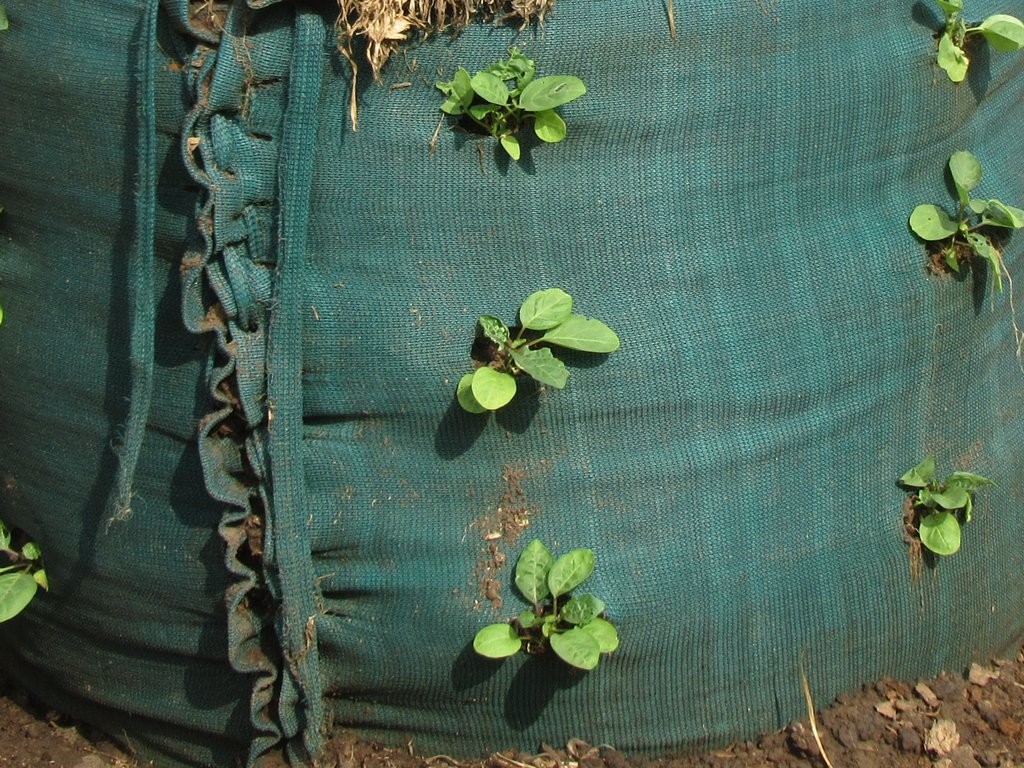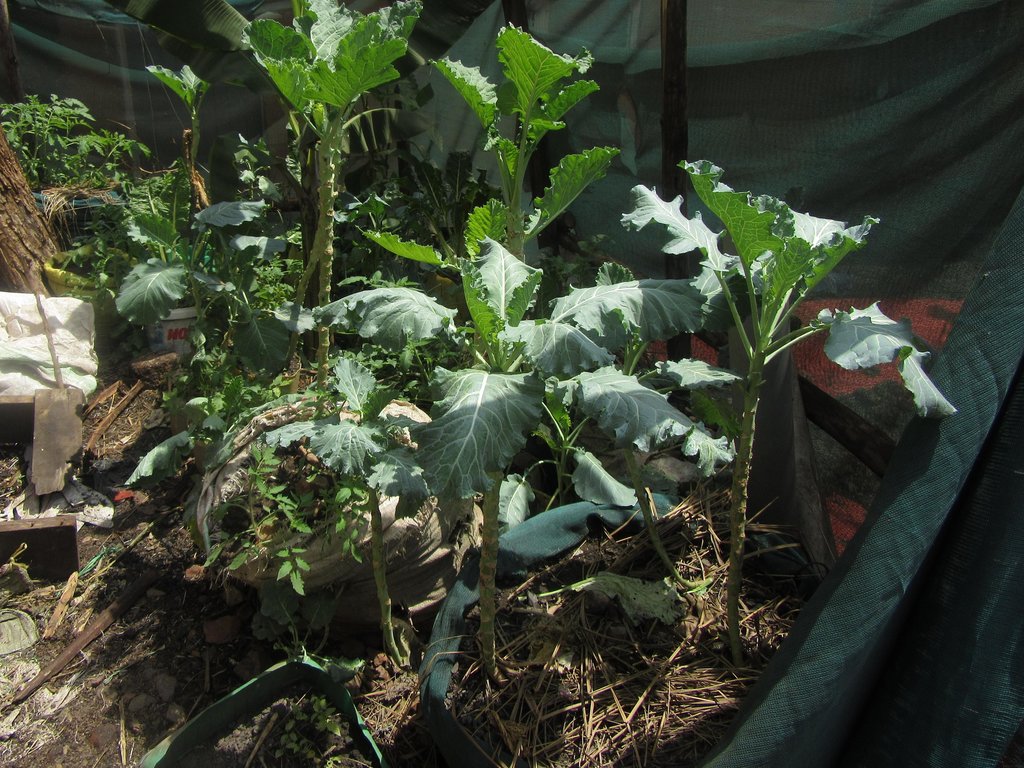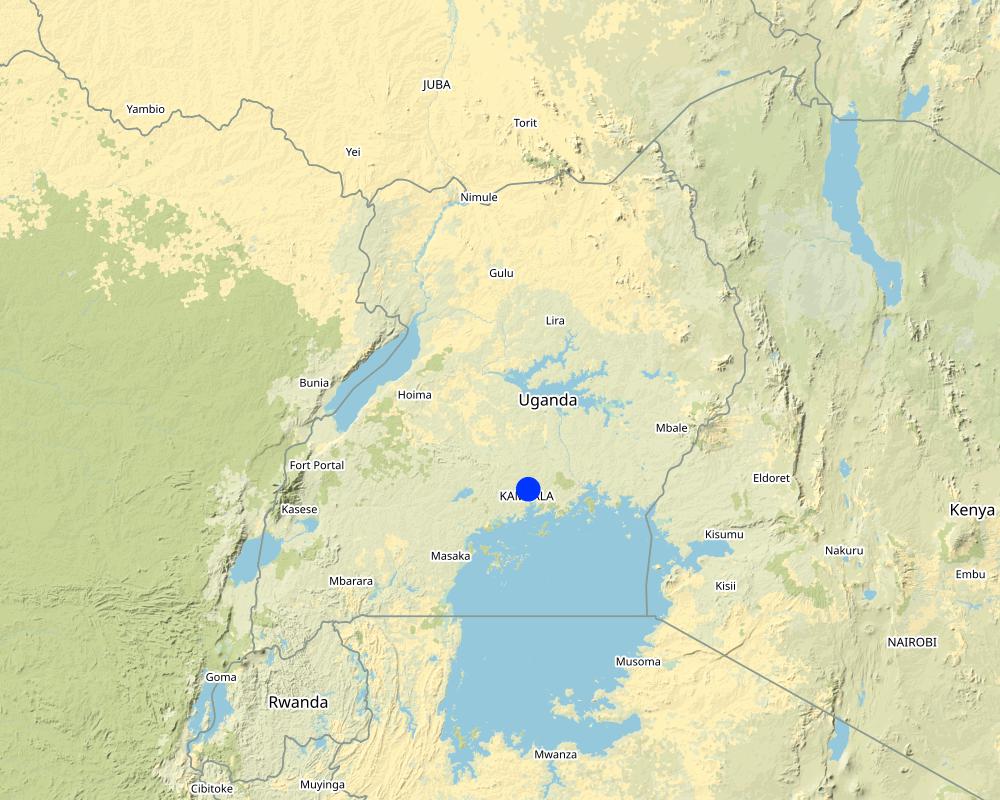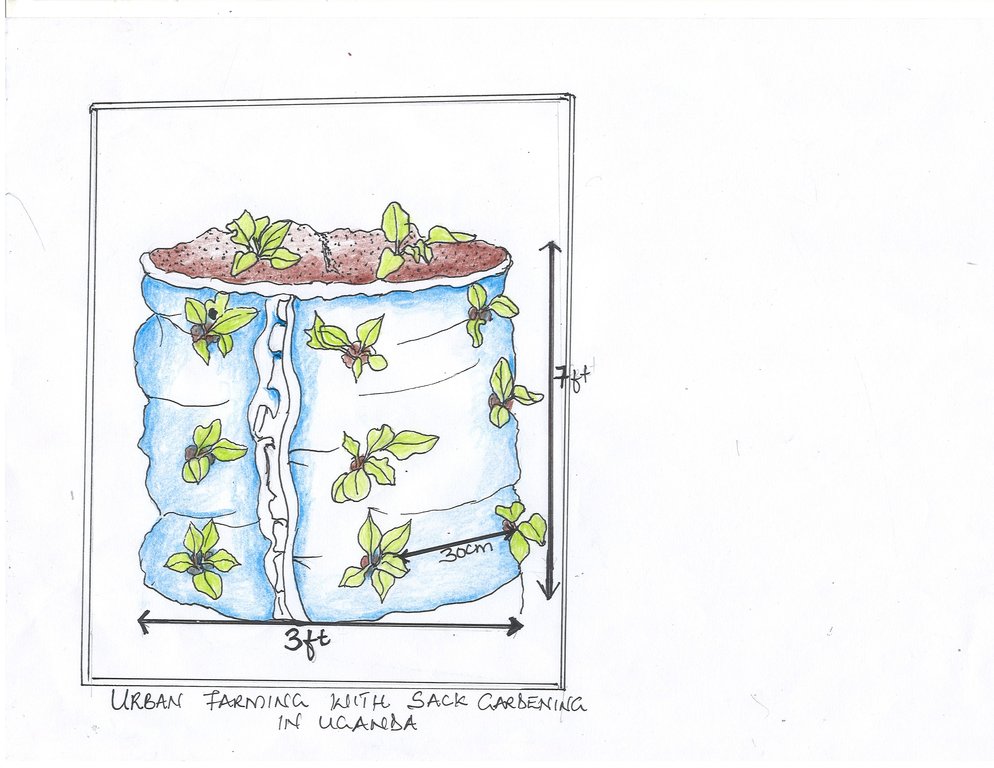Urban farming with sack gardening [乌干达]
- 创建:
- 更新:
- 编制者: Babirye Irene
- 编辑者: Jalia Namakula, Kamugisha Rick Nelson
- 审查者: Nicole Harari, Udo Höggel
Okulimila mu kutiya
technologies_3452 - 乌干达
查看章节
全部展开 全部收起1. 一般信息
1.2 参与该技术评估和文件编制的资源人员和机构的联系方式
关键资源人
土地使用者:
Komuhangi Grace
+256758581024
NARO
Kamonkya 2, kisenyi 2 zone Kampala District.
乌干达
有助于对技术进行记录/评估的项目名称(如相关)
Scaling-up SLM practices by smallholder farmers (IFAD)有助于对技术进行记录/评估的机构名称(如相关)
National Agricultural Research Organisation (NARO) - 乌干达1.3 关于使用通过WOCAT记录的数据的条件
(现场)数据是什么时候汇编的?:
01/29/2018
编制者和关键资源人员接受有关使用通过WOCAT记录数据的条件。:
是
1.4 所述技术的可持续性声明
这里所描述的技术在土地退化方面是否存在问题,导致无法被认为是一种可持续的土地管理技术?:
否
注释:
The approach is seen as a cheap and healthy solution to food insecurity, its easy to establish on a very small scale.
2. SLM技术的说明
2.1 技术简介
技术定义:
Sack gardening is a technology that consists of a series of sacks that are filled with manure, soil and small stones that enable water to drain, from the tops and sides of the sacks, often referred to as multi-stoney gardens to increase production.
2.2 技术的详细说明
说明:
The technology is mostly promoted by farmers in Kampala District, Central Uganda and other parts of the country. The technology is seen as a cheap and healthy solution to food insecurity and runaway unemployment in Kampala’s slum. It is preferred by farmers because it's cheap, high-yielding and promoting food security while maximizing land and water use.
This technology is practiced in the slum area of Kisenyi 2 zone, Kamokya parish, Kampala District and was established in 2015, where the farmer got farming training from Kampala City Council Authority through demonstrations in the urban farming program. The main reasons for its establishment were; the ease to establishment and management, space optimization, no special skills required and affordability.
To establish such a technology the farmer started by collecting huge sacks of banana leaves that had been dumped around the neighborhood.
Black soil was mixed with chicken manure that was available. Small pebble stones were added and strong sticks placed in the middle of the sack, right from bottom to top. The sack was then filled with soil, leaving the stones erect in the middle. For an optimal production, the farmer used bags with a containing capacity of 50 to 100 kilograms. Additonal items were one polyethylene (food-safe bag. ie: rice bag) and a pipe of the height of the bag, opened at both ends, 15 to 20cm long.
The complete system consists of 50 kilos of soil, 25 kilos of fertilizer (compost, manure) which is adjusted according to the
quality of the soil plus 15 kilos of stones (3 to 7 cm diameter).
In some sacks the farmer grows tomatoes, cabbages and carrots. Usually the crops with big roots, like carrots, go on the top, and the sides are reserved for cabbages with small roots, she says. The sack garden is watered on a daily basis, twice a day if the weather is dry and once a day if the weather is humid. There is no such a thing as a crop-growing season. The garden is ever green, even during the dry season. The farmer makes 0.6$ selling spinach to neighbors, and 0.84$ selling produce to the market. This translates to about 27.8$ per month, after deducting expenses.
Sack gardening is very advantageous to the farmer and other farmers are trained in the technology by the farmer who started it. The farmer receives an equivalent of 1.39$ a day. For 20 training days this totals to 27.8$ a month from tutoring a women group in Kamokya. This additonal income helps the farmer securing enough money to meet needs like school fees, food and utility payments. It also provides a secure source of nutritional food, facilitates growing of vegetables in areas without suitable soils or adequate space, promotes efficient and effective utilization of available water and nutrients.
2.3 技术照片
2.4 技术视频
注释、简短说明:
Video of sack gardening.
日期:
22/3/2018
位置:
Kamonkya village , Kampala District
摄影师的名字:
Irene Babirye
2.5 已应用该技术的、本评估所涵盖的国家/地区/地点
国家:
乌干达
区域/州/省:
Central Region
Map
×2.6 实施日期
注明实施年份:
2016
2.7 技术介绍
详细说明该技术是如何引入的:
- 在实验/研究期间
注释(项目类型等):
Through urban farming demonstrations .
3. SLM技术的分类
3.1 该技术的主要目的
- 改良生产
- 创造有益的经济影响
- 创造有益的社会影响
3.2 应用该技术的当前土地利用类型

农田
- 一年一作
主要农作物(经济作物及粮食作物):
Tomatoes, cabbages, sukuma wiki and cabbages.
注释:
The farmer has several sacks with different vegetables.
3.3 有关土地利用的更多信息
该技术所应用土地的供水:
- 混合雨水灌溉
每年的生长季节数:
- 1
具体说明:
The technology is established/grown once and harvested through the year.
3.4 该技术所属的SLM组
- 最小的土壤扰动
- 家庭花园
3.5 技术传播
具体说明该技术的分布:
- 适用于特定场所/集中在较小区域
3.6 包含该技术的可持续土地管理措施

农艺措施
- A2:有机质/土壤肥力
- A5:种子管理,改良品种
3.7 该技术强调的主要土地退化类型

土壤水蚀
- Wt:表土流失/地表侵蚀

生物性退化
- Bc:植被覆盖的减少
3.8 防止、减少或恢复土地退化
具体数量名该技术与土地退化有关的目标:
- 不适用
4. 技术规范、实施活动、投入和成本
4.1 该技术的技术图纸
4.2 技术规范/技术图纸说明
The sack is vertical with 10-15 cm.
Vegetables planted include Carrots, Tomatoes and Sukuma wikki
4.3 有关投入和成本计算的一般信息
具体说明成本和投入是如何计算的:
- 每个技术单元
具体说明成本计算所用货币:
- 美元
注明美元与当地货币的汇率(如相关):1美元=:
3600.0
注明雇用劳工的每日平均工资成本:
2.78$
4.4 技术建立活动
| 活动 | 措施类型 | 时间 | |
|---|---|---|---|
| 1. | Clearing a nursery bed | 管理 | 1 day |
| 2. | Planting the seeds in the nursery bed | 1 day | |
| 3. | Mixing compost manure with soil | 1 day | |
| 4. | Buying the bags | 管理 | 1 day |
| 5. | Filling the sack with soil, sticks and stones | 1 day | |
| 6. | Transplanting | 3 days | |
| 7. | Harvesting | Once a week | |
| 8. | Spraying | Daily |
4.5 技术建立所需要的费用和投入
| 对投入进行具体说明 | 单位 | 数量 | 单位成本 | 每项投入的总成本 | 土地使用者承担的成本% | |
|---|---|---|---|---|---|---|
| 劳动力 | Sack fiiling | Man day | 5.0 | 1.39 | 6.95 | 100.0 |
| 劳动力 | Nursery bed preparation | Man day | 2.0 | 1.39 | 2.78 | 100.0 |
| 劳动力 | Transplanting | Man day | 5.0 | 1.39 | 6.95 | 100.0 |
| 劳动力 | spraying | Man day | 1.0 | 1.39 | 1.39 | 100.0 |
| 设备 | Hoes | Pieces | 2.0 | 2.78 | 5.56 | 100.0 |
| 设备 | Wheelbarrow | Piece | 1.0 | 27.78 | 27.78 | 100.0 |
| 设备 | Sprayer pump | Piece | 1.0 | 13.89 | 13.89 | 100.0 |
| 设备 | Sacks | Pack | 10.0 | 4.167 | 41.67 | 100.0 |
| 植物材料 | Tomato seeds | kg | 1.0 | 1.95 | 1.95 | 100.0 |
| 植物材料 | Cabbage seeds | kg | 1.0 | 1.95 | 1.95 | 100.0 |
| 植物材料 | Carrots seeds | kg | 1.0 | 2.3 | 2.3 | 100.0 |
| 植物材料 | Sukuma wiki seeds | kg | 1.0 | 1.95 | 1.95 | 100.0 |
| 肥料和杀菌剂 | Compost manure | Bags | 12.0 | 1.95 | 23.4 | 100.0 |
| 肥料和杀菌剂 | Dythene pestcides | kg | 1.0 | 6.95 | 6.95 | 100.0 |
| 肥料和杀菌剂 | Dudu cyper pestcides | litre | 1.0 | 2.78 | 2.78 | 100.0 |
| 施工材料 | Stones | Trip | 0.5 | 8.34 | 4.17 | 100.0 |
| 技术建立所需总成本 | 152.42 | |||||
注释:
The farmer had ready capital to establish the technology
4.6 维护/经常性活动
| 活动 | 措施类型 | 时间/频率 | |
|---|---|---|---|
| 1. | Watering | 管理 | Everyday |
| 2. | Spraying | 管理 | Once in two weeks |
| 3. | Weeding | 管理 | Once a week |
| 4. | Harvesting | 管理 | Every day |
注释:
The farmer does all the maintenance activities. There are no costs.
4.7 维护/经常性活动所需要的费用和投入(每年)
| 对投入进行具体说明 | 单位 | 数量 | 单位成本 | 每项投入的总成本 | 土地使用者承担的成本% | |
|---|---|---|---|---|---|---|
| 劳动力 | Harvesting | Man day | 0.5 | 2.7 | 1.35 | 100.0 |
| 劳动力 | Weeding | Man day | 0.5 | 2.7 | 1.35 | 100.0 |
| 肥料和杀菌剂 | Dithane pestcides | kg | 1.0 | 7.0 | 7.0 | 100.0 |
| 肥料和杀菌剂 | Dudu cyper pestcides | litre | 1.0 | 2.7 | 2.7 | 100.0 |
| 技术维护所需总成本 | 12.4 | |||||
4.8 影响成本的最重要因素
描述影响成本的最决定性因素:
Pestcides costs affect the technology.
5. 自然和人文环境
5.1 气候
年降雨量
- < 250毫米
- 251-500毫米
- 501-750毫米
- 751-1,000毫米
- 1,001-1,500毫米
- 1,501-2,000毫米
- 2,001-3,000毫米
- 3,001-4,000毫米
- > 4,000毫米
农业气候带
- 潮湿的
5.2 地形
平均坡度:
- 水平(0-2%)
- 缓降(3-5%)
- 平缓(6-10%)
- 滚坡(11-15%)
- 崎岖(16-30%)
- 陡峭(31-60%)
- 非常陡峭(>60%)
地形:
- 高原/平原
- 山脊
- 山坡
- 山地斜坡
- 麓坡
- 谷底
垂直分布带:
- 0-100 m a.s.l.
- 101-500 m a.s.l.
- 501-1,000 m a.s.l.
- 1,001-1,500 m a.s.l.
- 1,501-2,000 m a.s.l.
- 2,001-2,500 m a.s.l.
- 2,501-3,000 m a.s.l.
- 3,001-4,000 m a.s.l.
- > 4,000 m a.s.l.
说明该技术是否专门应用于:
- 不相关
5.3 土壤
平均土层深度:
- 非常浅(0-20厘米)
- 浅(21-50厘米)
- 中等深度(51-80厘米)
- 深(81-120厘米)
- 非常深(> 120厘米)
土壤质地(表土):
- 中粒(壤土、粉土)
土壤质地(地表以下> 20厘米):
- 中粒(壤土、粉土)
表土有机质:
- 中(1-3%)
5.4 水资源可用性和质量
地下水位表:
> 50米
地表水的可用性:
好
水质(未处理):
良好饮用水
水的盐度有问题吗?:
否
该区域正在发生洪水吗?:
否
关于水质和水量的注释和进一步规范:
The farmer taps National Water, which provides good clean water.
5.5 生物多样性
物种多样性:
- 中等
栖息地多样性:
- 低
5.6 应用该技术的土地使用者的特征
其它(具体说明):
Urban setting
生产系统的市场定位:
- 混合(生计/商业
非农收入:
- 低于全部收入的10%
相对财富水平:
- 平均水平
个人或集体:
- 个人/家庭
机械化水平:
- 手工作业
性别:
- 女人
土地使用者的年龄:
- 中年人
说明土地使用者的其他有关特征:
She's a married woman with five children.
5.7 应用该技术的土地使用者拥有或租用的平均土地面积
- < 0.5 公顷
- 0.5-1 公顷
- 1-2 公顷
- 2-5公顷
- 5-15公顷
- 15-50公顷
- 50-100公顷
- 100-500公顷
- 500-1,000公顷
- 1,000-10,000公顷
- > 10,000公顷
这被认为是小规模、中规模还是大规模的(参照当地实际情况)?:
- 小规模的
注释:
The technology is practiced at home.
5.8 土地所有权、土地使用权和水使用权
- Urban slum
土地使用权:
- 自由进入(无组织)
用水权:
- 社区(有组织)
5.9 进入服务和基础设施的通道
健康:
- 贫瘠
- 适度的
- 好
教育:
- 贫瘠
- 适度的
- 好
技术援助:
- 贫瘠
- 适度的
- 好
就业(例如非农):
- 贫瘠
- 适度的
- 好
市场:
- 贫瘠
- 适度的
- 好
能源:
- 贫瘠
- 适度的
- 好
道路和交通:
- 贫瘠
- 适度的
- 好
饮用水和卫生设施:
- 贫瘠
- 适度的
- 好
金融服务:
- 贫瘠
- 适度的
- 好
6. 影响和结论性说明
6.1 该技术的现场影响
社会经济效应
生产
作物生产
SLM之前的数量:
Had 2 sacks
SLM之后的数量:
She has 10 sacks
注释/具体说明:
The farmer acquired skills in sustainable sack garnening
作物质量
SLM之前的数量:
Vegetable quality were vere low
SLM之后的数量:
Improved quality
注释/具体说明:
She maintains the garden on a daily basis
生产故障风险
SLM之前的数量:
She didnot spray the plants
SLM之后的数量:
Sprays the plants as directed
注释/具体说明:
The farmer has enough skills in sack gardening
收入和成本
农业投入费用
注释/具体说明:
She use compost manure
农业收入
SLM之前的数量:
She used to 0.6$ day
SLM之后的数量:
She gets 0.84$ a day
注释/具体说明:
Reduced maintenance costs and high yields
社会文化影响
食品安全/自给自足
SLM之前的数量:
Vegetables were bought from the market
SLM之后的数量:
Vegetables are harvested and sold to the market
生态影响
土壤
土壤流失
注释/具体说明:
This sack based technology reduces the need to establish vegetable gardening on open ground thus reduces the risk of soil losses
6.3 技术对渐变气候以及与气候相关的极端情况/灾害的暴露和敏感性(土地使用者认为的极端情况/灾害)
渐变气候
渐变气候
| 季节 | 气候变化/极端天气的类型 | 该技术是如何应对的? | |
|---|---|---|---|
| 年温度 | 减少 | 适度 | |
| 季节性温度 | 湿季/雨季 | 减少 | 适度 |
气候有关的极端情况(灾害)
生物灾害
| 该技术是如何应对的? | |
|---|---|
| 昆虫/蠕虫侵扰 | 不好 |
6.4 成本效益分析
技术收益与技术建立成本相比如何(从土地使用者的角度看)?
短期回报:
积极
长期回报:
非常积极
技术收益与技术维护成本/经常性成本相比如何(从土地使用者的角度看)?
短期回报:
非常积极
长期回报:
非常积极
注释:
She doesn't spend too much on maintenance since she does all the activities by her self.
6.5 技术采用
- 1-10%
如若可行,进行量化(住户数量和/或覆盖面积):
4
在所有采用这项技术的人当中,有多少人是自发地采用该技术,即未获得任何物质奖励/付款?:
- 90-100%
注释:
All cost borne by producer
6.6 适应
最近是否对该技术进行了修改以适应不断变化的条件?:
否
6.7 该技术的优点/长处/机会
| 土地使用者眼中的长处/优势/机会 |
|---|
| Its a source of fresh greens and income. |
| It is very cheap to establish and maintain. |
| It allows many plants to grow from the same sack |
| 编制者或其他关键资源人员认为的长处/优势/机会 |
|---|
| The technology is not labor demanding since the farmer does all the activities. |
| It motivates people to adopt it. |
| Optimal utilization of the land. |
6.8 技术的弱点/缺点/风险及其克服方法
| 土地使用者认为的弱点/缺点/风险 | 如何克服它们? |
|---|---|
| The technology is relatively expensive to establish. | Start small for example a farmer should start with two sacks. |
| It requires ready market. | First get ready market before harvesting. |
| 编制者或其他关键资源人员认为的弱点/缺点/风险 | 如何克服它们? |
|---|---|
| The technology requires full time maintenance for example watering of the plants. | The farmer should be available to do all the maintenance activities. |
| It's well practiced in a home for security purposes. | If its not practiced at a home, a farmer should provide security of the garden. |
| Pests and diseases. | The farmer should spray as directed to prevent pests and diseases. |
7. 参考和链接
7.1 信息的方法/来源
- 实地考察、实地调查
1
- 与土地使用者的访谈
1
- 与SLM专业人员/专家的访谈
1
- 根据报告和其他现有文档进行编译
1
链接和模块
全部展开 全部收起链接
无链接
模块
无模块






